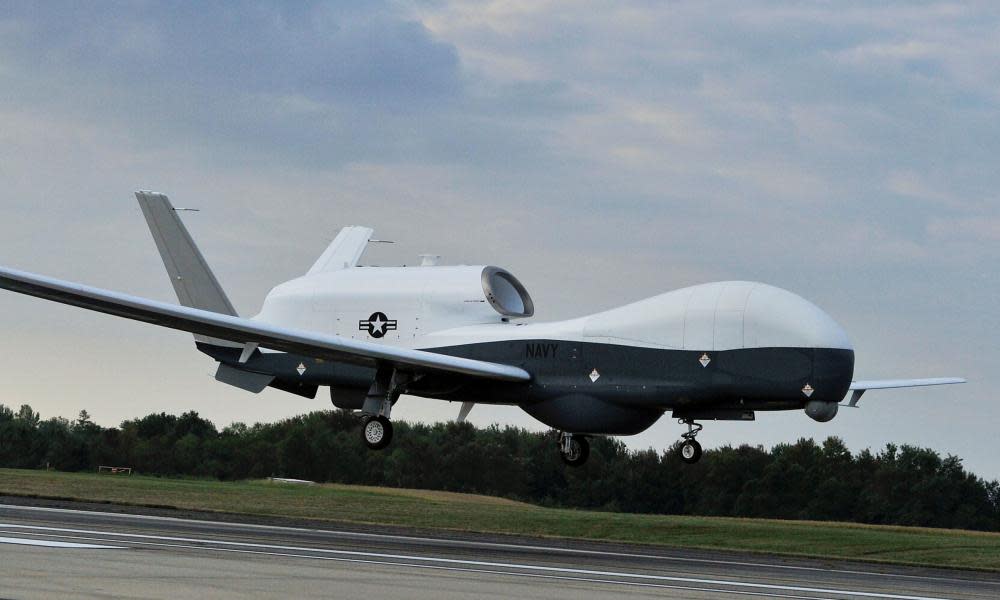Iran shoots down US drone

Iran has shot down an US drone in the strait of Hormuz, accusing Washington of breaching Iran’s national sovereignty and trying to deepen tensions in the region.
Iran’s Revolutionary Guards said on Thursday that they had used a surface to air missile to shoot down what they called a US “spy” drone they claimed was flying in the country’s airspace.
The US military confirmed that one of its unmanned aircraft had been taken down, but said it was in international airspace. The official said the drone was a US navy MQ-4C Triton.
The US military accused Iran last week of firing a missile at another drone that responded to the oil tanker attacks near the Gulf of Oman.
Tensions in the Gulf have been heightened since 13 June, when the US accused Iran of attacking two tankers in the the Gulf of Oman with mines. The US military released footage it said showed the Iranian military removing an unexploded mine from the side of one of the tankers. There have also allegedly been Iranian-inspired attacks on US oil and military assets in Iraq, and increasingly sophisticated weaponry being fired into Saudi Arabia by Houthi rebels.
The Iranian state news agency said the downed drone was an RQ-4 Global Hawk. “It was shot down when it entered Iran’s airspace near the Kouhmobarak district in the south,” the Revolutionary Guards’ website added.
The secretary of Iran’s supreme national security council, Ali Shamkhani, had said on Wednesday that Tehran would respond to any intrusion into its airspace or waters.
Shamkhani emphasised that Iran robustly protects its aerial and maritime borders, describing its airspace as the country’s “red line”. “No matter whose plane trespasses into it, we have always given and will give a harsh response to intruders.”
Related: The Iran crisis was created in Washington. The US must be talked down | Simon Tisdall
He insisted Iran was the guarantor of security in the Gulf and strait of Hormuz.
The chairman of the Iranian parliament’s national security and foreign policy commission, Heshmatollah Falahatpisheh, urged the Iranian government to file a complaint to the United Nations on the alleged US drone intrusion into its territory. He said: “US drone intrusion to the Iranian airspace is clear violation of the UN charter and national sovereignty of the country.”
Both Washington and Tehran insist they are intent on avoiding a war as tensions build over the consequences of the US withdrawal from the Iran nuclear deal in May 2018, but fears that an accidental chain of events will lead to escalation and finally a military confrontation are growing.
The shooting down of the drone came as the US president, Donald Trump, was briefed on the details of a separate incident: a further missile strike in Saudi Arabia that appeared to come from Iran-backed Houthi rebels in Yemen.
The White House spokeswoman, Sarah Sanders, said on Wednesday in relation to the Saudi missile strike: “We are closely monitoring the situation and continuing to consult with our partners and allies.”
Iran-aligned Houthis in Yemen, who ousted the internationally recognised Saudi-backed government in late 2014, have stepped up missile and drone attacks on Saudi civilian, military and oil installations in the past two weeks. Saudi Arabia claims Iranian experts are advising the Houthis.
The US has deployed an aircraft carrier to the Middle East in recent weeks and added additional troops to the tens of thousands already in the region.
Iran has set a deadline of 27 June by which it will breach limits on uranium stockpiles set out in the nuclear deal, a development likely to lead to renewed US demands that the EU states France, Germany and Britain join the US in pulling out of the deal. Iran says it is gradually suspending its adherence to the deal in response to the economic stranglehold being imposed on the country by US sanctions.
A meeting of the joint commission that oversees the deal, known as the Joint Comprehensive Plan of Action, is due to meet on 28 June in Vienna – bringing together Iran, the three EU states, China, as well as Russia. The EU will urge Iran not to take further steps to pull out of the deal, and may put Iran’s actions into the JCPOA’s lengthy dispute mechanism.

 Yahoo News
Yahoo News 
